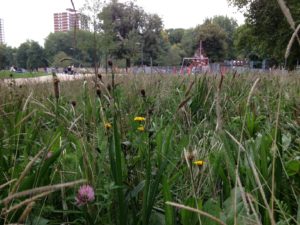The timing for cutting a wildflower meadow is always a bit of a dilemma, and an often asked question. In my opinion there are pros and cons to cutting early or late.
Leaving the meadow long is a very good idea as a habitat for wildlife. It provides shelter and a good source of food for all sorts of animals and insects. It can also be a picturesque scene with some late species flowering (Common Toadflax seems prolific this year as a late flowerer) and crisp frosty mornings making it look lovely.
But you have to weigh that up against the long term health of the wildflower meadow. To maintain species diversity, it is important that fertility is kept reasonably low, and the best way to do this is to cut and remove the cutting in the area. The longer you leave this the less fertility you remove because as the plant material breaks down in the autumn/early winter it falls to the soil and acts as a fertiliser (albeit a very light dose). So although you may still cut and remove the area late in the winter you will inevitably be removing less material as it will be impossible to pick up all the leaf etc that has broken down/rotted before you get to it.
There is also a compromise to the look of the area with a late cut. If you cut and remove while there are still reasonable growing conditions (ie day length and warm nights) the area will recover and go into the winter as a green and healthy area as there will be good regrowth in a relatively short time. By cutting late winter this will not happen to the same extent and so the area will go through the winter fairly bare. This does not harm the health of the meadow but does have a cosmetic implication.
You are right about it being a bit harder work late in the year as it has all toppled, but there is slightly less material to clear for the above reasons. One good reason to not leave it too late is if there are trees nearby and there are leaves falling. It is important these are cleared and it is easier to do this when the area is cut back and cleared, rather than if you are having to cut back and clear the arising’s as well as a lot of leaf material.
I think there is a compromise to be found by not sticking to one regime and varying the husbandry methods from year to year. So one year leave it late, but the next go for an early cut. Or splitting the area in two and rotate. This is good as it leaves an area tall for the animals to migrate to from the early cut area.
We also have clients who cut in late June as this extends the flowering season, whist reducing the amount of material that needs to be collected in the autumn.
So in my opinion there is no prescriptive routine. The important thing is to have a well-established meadow in the first place and then vary the routine from year to year, and also within the meadow area if it is big enough.
Finally, we run training days in meadow establishment and maintenance for landscape contractors and architects/designers – please email if you would like details. We are full this autumn, but will run more next spring. And completing the training entitles you to a discount on our Wildflower Turf!
I hope this helps!
